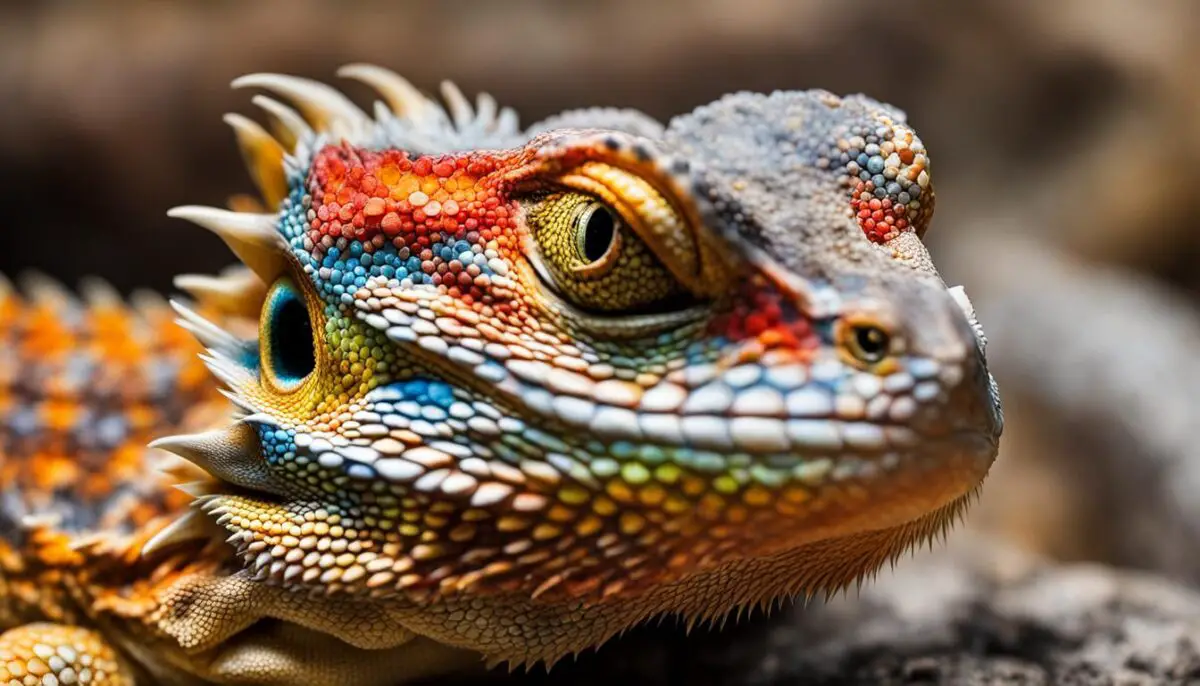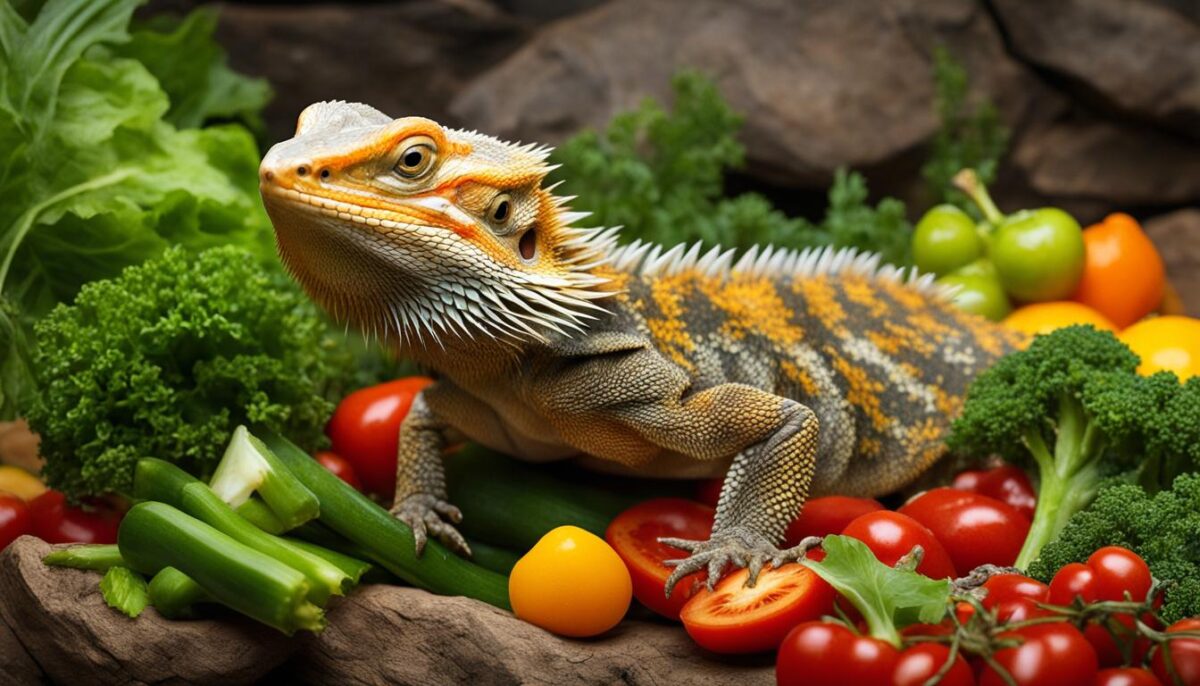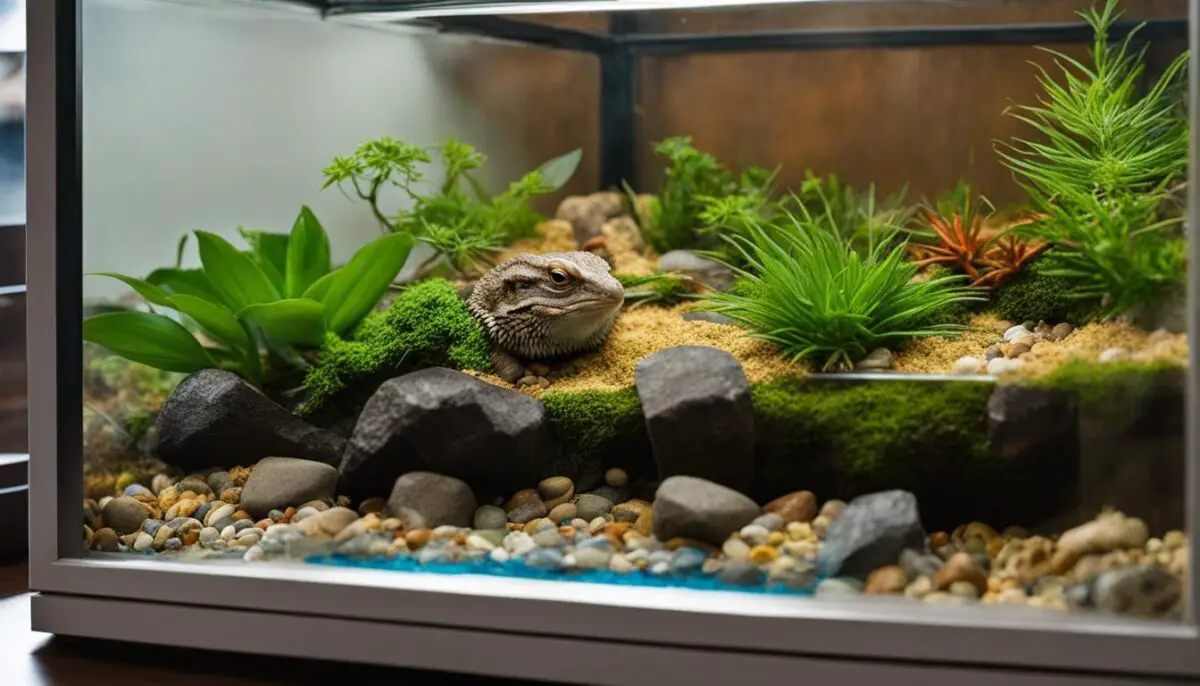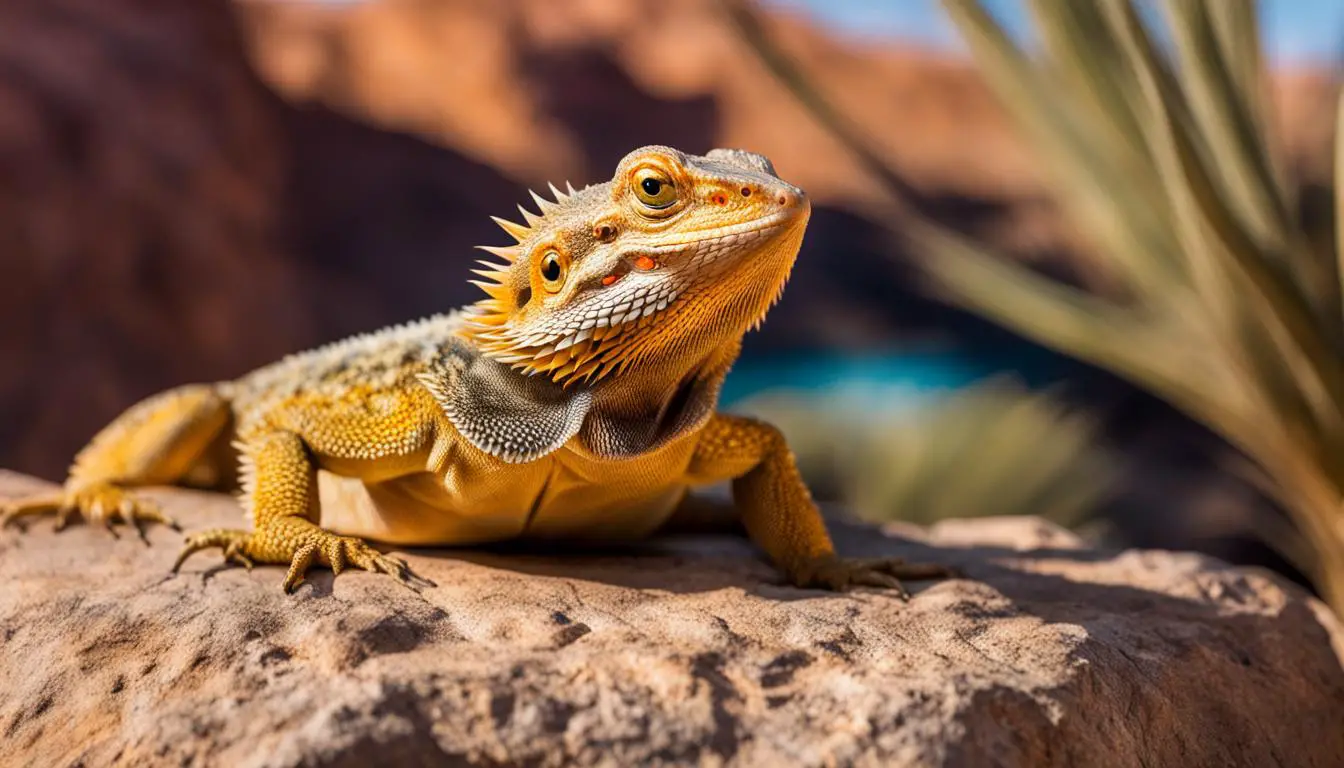Welcome to our comprehensive guide on caring for your bearded dragon when it reaches 1 year old. Bearded dragons are fascinating reptile pets known for their unique personalities and playful behavior. In this guide, we will provide you with all the information you need to ensure the well-being of your bearded dragon at this crucial stage of its life.
Key Takeaways:
- Proper diet and habitat are essential for the health of your bearded dragon 1 year old.
- Bearded dragons communicate through body language, such as head bobbing and arm waving.
- Understanding the anatomy of your bearded dragon will help you provide appropriate care.
- Bearded dragons grow rapidly during their first year, so monitoring their size and weight is important.
- With proper care, bearded dragons can live around 8 to 10 years.
Bearded Dragon Facts
Bearded dragons, scientifically known as Pogona vitticeps, are fascinating reptiles native to the dry bushland and desert regions of Australia. Here are some interesting facts about these unique creatures:
- Bearded dragons get their name from the spiky growths under their necks that puff up and turn black when they are excited, resembling a beard.
- They are part of the Agamidae family, which includes other remarkable lizard species.
- Bearded dragons are omnivorous, meaning they eat both plant and animal matter, making their diet diverse and varied.
- These lizards communicate through body language, such as head bobbing and arm waving, enabling them to express their emotions and intentions to others.
- While bearded dragons make great pet lizards due to their docile nature, it is crucial to handle them with care and provide them with a suitable environment.
- In captivity, bearded dragons have a lifespan of around 10 years, making them long-term companions for those who choose to care for them.
- It’s important to note that all bearded dragons available in the international market are captive bred, ensuring better acclimation to domestic environments.
Now that you’re familiar with these intriguing bearded dragon facts, let’s dive deeper into their anatomy and learn more about this remarkable species.
Table: Bearded Dragon Facts
| Fact | Description |
|---|---|
| Scientific Name | Pogona vitticeps |
| Habitat | Dry bushland and desert regions of Australia |
| Characteristic | Spiky growths under their necks resembling a beard |
| Diet | Omnivorous – eat both plant and animal matter |
| Communication | Body language: head bobbing and arm waving |
| Lifespan | Around 10 years in captivity |
| Origin | Captive bred in the international market |
Bearded Dragon Anatomy
Understanding the anatomy of your bearded dragon is essential for providing proper care and recognizing any potential health issues. These fascinating reptiles have unique physical features that contribute to their overall well-being.
Head:
The head of a bearded dragon is triangular in shape with a short snout. They have mobile eyes and a parietal eye on the top of their heads, which helps them detect changes in light intensity. Bearded dragons also have a wide mouth with teeth weakly attached to their jawbones. Their long tongue is equipped for catching prey.

Body:
The body of a bearded dragon is rounded and covered with spines of different sizes, which can change color to blend with their surroundings. Their strong and stubby legs have five clawed toes on each foot. The tail is moderate in size, thick at the base, and narrows down towards the tip. It’s important to note that bearded dragons cannot regenerate their tails if they are lost or damaged.
Internal Organs:
Bearded dragons have a unique anatomy when it comes to their internal organs. They have a three-chambered heart, allowing them to control blood flow patterns for efficient body temperature control. This adaptation enables them to effectively regulate their body heat based on external conditions. Additionally, bearded dragons have nostrils and ears with visible eardrums, which play a role in their sensory perception.
| Body Part | Description |
|---|---|
| Head | Triangular shape with a short snout, mobile eyes, and a parietal eye. |
| Body | Rounded body covered with spines and strong, stubby legs with five clawed toes on each foot. |
| Internal Organs | Three-chambered heart for efficient temperature control, nostrils, and visible eardrums. |
Understanding the anatomy of your bearded dragon will help you better care for and appreciate these remarkable reptiles. By providing them with the right environment and nourishment, you can ensure their overall health and happiness.
Bearded Dragon Size & Weight
Understanding the average size and weight of a bearded dragon is essential for providing proper care and ensuring their well-being. As your bearded dragon reaches 1 year old, it’s important to know what to expect in terms of their growth and development.
At 1 year old, bearded dragons are considered young adults and have gone through a significant growth spurt. On average, they reach a size of 16 to 22 inches in length. Males tend to be slightly larger than females.
In terms of weight, adult bearded dragons typically weigh between 10 to 18 ounces (283 to 511 grams). However, it’s important to note that individual sizes and weights can vary based on genetics and overall health.
To better understand the size and weight of your bearded dragon, it’s advisable to monitor their growth regularly and consult with a veterinarian if you have any concerns. You can also refer to the table below for a visual representation of the average size and weight of bearded dragons at 1 year old.
| Age | Size | Weight |
|---|---|---|
| 1 year old | 16 to 22 inches | 10 to 18 ounces |
Remember, providing a spacious and suitable enclosure, a balanced diet, and proper care are crucial for promoting healthy growth and development in your bearded dragon. By understanding their size and weight requirements, you can ensure they have a comfortable and thriving life as they continue to grow.
Bearded Dragon Lifespan
One of the key considerations for bearded dragon owners is understanding the lifespan of these fascinating reptiles. With proper care and attention, bearded dragons can live around 8 to 10 years, with some individuals even surpassing this lifespan. It is important to note that females tend to have shorter lifespans, especially if they have been used for breeding.
The oldest recorded bearded dragon lived to be almost 19 years old, showcasing the potential longevity of these reptiles when provided with the right care. To maximize their lifespan, it is crucial to provide them with proper nutrition, a suitable habitat, and regular veterinary care.
By offering a balanced diet consisting of both plant-based and animal-based foods, you can ensure that your bearded dragon receives the essential nutrients it needs for optimal health and longevity. Additionally, maintaining the correct environmental conditions, including appropriate lighting and temperature gradients, is vital for their overall well-being.
Remember, bearded dragons are long-term commitments, so it is essential to be prepared for the responsibilities that come with their care. By providing them with the right conditions and attentive care, you can enjoy the companionship of these incredible reptiles for many years.
| Key Points | Details |
|---|---|
| Bearded Dragon Lifespan | Average lifespan of 8 to 10 years |
| Variations | Some individuals may live longer |
| Gender Differences | Females tend to have shorter lifespans, especially if used for breeding |
| Optimal Care | Proper diet, suitable habitat, and regular veterinary care |
| Nutrition | Provide a balanced diet of plant-based and animal-based foods |
| Environmental Conditions | Maintain appropriate lighting, temperature, and habitat conditions |
Bearded Dragon Behavior & Health
Understanding the behavior and health of your bearded dragon is crucial for providing optimal care. These reptiles have unique behaviors that serve as indicators of their well-being. By observing their body language, such as head bobbing and arm waving, you can gauge their mood and overall health.
Monitoring their behavior is particularly important when it comes to assessing their appetite. A healthy bearded dragon will show enthusiasm for mealtime, eagerly consuming a balanced diet of insects, vegetables, fruits, and greens. It’s essential to provide a varied diet that meets their nutritional needs and supplement it with calcium and multivitamins to support their overall health.
Just like any other pet, bearded dragons are susceptible to certain health issues. Metabolic bone disease, caused by a lack of calcium and vitamin D3, is a common concern. It’s crucial to provide appropriate lighting, including UVB lighting, to promote vitamin D3 synthesis and prevent this disease. Respiratory infections are also a potential risk, so maintaining a clean and well-ventilated habitat is essential.
Table: Common Health Issues in Bearded Dragons
| Health Issue | Symptoms | Treatment |
|---|---|---|
| Metabolic Bone Disease | Soft, deformed bones; swelling in limbs or jaws; weak muscles; difficulty walking or climbing | Calcium and vitamin D3 supplementation; optimizing lighting; veterinary care |
| Respiratory Infections | Wheezing or crackling sound when breathing; mucus or discharge from nose or mouth; loss of appetite | Antibiotics prescribed by a veterinarian; maintaining a clean, well-ventilated habitat |
| Parasites | Weight loss; diarrhea; lethargy; dull or discolored skin; visible parasites in feces | Antiparasitic medication prescribed by a veterinarian; maintaining a clean habitat |
Proper care, regular veterinary check-ups, and a well-maintained habitat are essential for ensuring the health and happiness of your bearded dragon. By understanding their behavior, providing a balanced diet, and addressing any health issues promptly, you can enjoy many years of companionship with your scaly friend.
Remember, each bearded dragon is unique, so it’s important to monitor their behavior and consult a veterinarian if you notice any concerning changes. With proper care and attention, your bearded dragon can live a long and healthy life.

| Animal-Based Foods | Plant-Based Foods |
|---|---|
| Crickets | Kale |
| Mealworms | Collard Greens |
| Dubia roaches | Dandelion Greens |
| Phoenix worms | Squash |
It is important to provide a varied diet to ensure your bearded dragon receives all the necessary nutrients. This can be achieved by offering a rotation of different insects and a variety of vegetables and greens. Proper supplementation with calcium and multivitamins is also important for their overall health.
Remember to avoid feeding your bearded dragon any toxic or potentially harmful foods. Some examples include avocado, rhubarb, and onions. Additionally, be sure to provide fresh, clean water for your bearded dragon at all times.
Feeding Frequency
The feeding frequency for a bearded dragon can vary depending on its age. Baby bearded dragons should be fed 2-3 times a day, while adults can be fed once a day or every other day. It is essential to monitor their weight and adjust the feeding frequency accordingly to prevent obesity or malnourishment.
In conclusion, providing a well-balanced diet is essential for the health and longevity of your bearded dragon. By offering a variety of insects, vegetables, and greens, and providing proper supplementation, you can ensure that your bearded dragon receives all the necessary nutrients for a happy and healthy life.
Bearded Dragon Habitat
Creating a suitable habitat for your bearded dragon is crucial for its overall well-being. The habitat should mimic its natural environment, providing a comfortable and safe space for your pet reptile to thrive. Here are some key elements to consider when setting up a bearded dragon enclosure:
Enclosure Size and Design
The enclosure should be spacious enough to allow your bearded dragon to move around freely. A minimum size of 120 gallons (48”L x 24”W x 24”H) is recommended. Opt for a front-opening design for easy access and ensure proper ventilation to maintain a healthy environment.
Lighting and Temperature
Proper lighting is essential for your bearded dragon’s health. Provide a UVB light source to ensure adequate vitamin D synthesis, which is necessary for calcium absorption. Use a basking spot lamp to create a temperature gradient in the enclosure, with a warm basking area of around 100-110°F (37-43°C) and a cooler side around 80-85°F (27-29°C).
Substrate and Enrichment
Choose a suitable substrate for your bearded dragon’s enclosure. Fine sand or sandy soil can be used, but avoid loose substrates that can be ingested and cause impaction. Add enrichment items like rocks, branches, and hiding spots to create a stimulating environment that mimics the bearded dragon’s natural habitat.

| Habitat Element | Recommended | Not Recommended |
|---|---|---|
| Enclosure Size | 120 gallons or larger | Too small or cramped enclosures |
| Lighting | UVB light for vitamin D synthesis | Inadequate or no UVB lighting |
| Temperature | Basking spot of 100-110°F (37-43°C) | Inconsistent or incorrect temperatures |
| Substrate | Fine sand or sandy soil | Loose substrates that can cause impaction |
| Enrichment | Adding rocks, branches, and hiding spots | Overcrowding or lack of hiding spots |
By providing a suitable habitat, you can create a comfortable and stimulating environment for your bearded dragon, promoting its overall health and happiness.
Baby Bearded Dragon Care
Taking care of a baby bearded dragon requires some extra attention and care compared to adult dragons. Here are some essential tips to ensure the well-being of your young reptile companion:
- Substrate: Choose a solid substrate, such as reptile carpet or paper towels, to prevent ingestion. Avoid loose substrates like sand, as they can be harmful if accidentally ingested.
- Heating and Lighting: Adjust the heat and lighting setup in the enclosure to accommodate the smaller size of a baby bearded dragon. Use a reptile-specific heat lamp and a UVB bulb to provide the necessary heat and light for their development.
- Feeding Frequency: Baby bearded dragons require frequent feedings to support their growth. Offer small, appropriately-sized insects, such as crickets or dubia roaches, multiple times a day. Ensure a variety of insects and gradually introduce vegetables and greens into their diet.
- Handling Techniques: When handling a baby bearded dragon, be gentle and cautious. Their bodies are delicate, so avoid excessive squeezing or pressure. Support their body with both hands and let them explore your hands at their own pace.
By providing the right substrate, adjusting the heating and lighting, feeding them appropriately, and handling them with care, you can create a safe and nurturing environment for your baby bearded dragon to thrive in.
| Aspect | Recommendation |
|---|---|
| Substrate | Use solid substrate like reptile carpet or paper towels to prevent ingestion. |
| Heating and Lighting | Adjust heat and lighting setup for a smaller size, using reptile-specific heat lamp and UVB bulb. |
| Feeding Frequency | Offer small, appropriately-sized insects multiple times a day, gradually introducing vegetables and greens. |
| Handling Techniques | Handle with gentle care, supporting their body with both hands and allowing them to explore at their own pace. |
Bearded Dragon Price
When considering getting a bearded dragon as a pet, it’s important to factor in the cost of purchasing and caring for one. The price of a bearded dragon can vary depending on several factors, including age, morph (color and pattern variation), and the breeder. On average, you can expect to pay between $50 to $150 for a bearded dragon.
However, the cost of the bearded dragon itself is just one part of the overall expense. You also need to consider the setup of their enclosure, which includes lighting, heating, and substrate. These initial setup costs can range from around $100 to $200, depending on the quality and type of equipment you choose.
Alongside the initial setup costs, ongoing expenses for maintaining a bearded dragon include food, supplements, and veterinary care. Bearded dragons require a varied diet that includes live insects, fresh vegetables, and fruits. The cost of food will depend on the size of your dragon and the availability of live insects in your area.
| Expense | Price Range |
|---|---|
| Bearded Dragon | $50 – $150 |
| Enclosure Setup | $100 – $200 |
| Food | Varies based on availability |
| Supplements | $10 – $20 per month |
| Veterinary Care | Varies based on need |
In addition to the financial investment, it’s important to consider the time and effort required to properly care for a bearded dragon. They require a suitable habitat with proper lighting, heating, and environmental enrichment. Regular veterinary check-ups are also recommended to ensure their health and well-being.
By understanding the cost involved in owning a bearded dragon and being prepared for the financial responsibility, you can provide your pet with the necessary care and create a happy and fulfilling relationship.
Conclusion
In conclusion, this comprehensive guide has provided you with all the necessary information to care for your bearded dragon when it reaches 1 year old. By understanding their specific needs and requirements, you can ensure the well-being and longevity of your pet.
Remember to provide a balanced diet that includes both animal-based and plant-based foods. Regular veterinary check-ups, along with appropriate lighting and temperature in their habitat, are essential for their overall health and happiness.
Creating a suitable enclosure with proper ventilation, substrate, and enrichment items will mimic their natural environment and provide a comfortable living space. This guide equips you with the knowledge and tools to be a responsible and knowledgeable bearded dragon owner.
FAQ
Are bearded dragons good pets?
Yes, bearded dragons make great pet lizards. They are docile and have unique personalities.
How long do bearded dragons live?
With proper care, bearded dragons can live around 8 to 10 years, sometimes even longer.
What should I feed my bearded dragon?
Bearded dragons are omnivorous and require a balanced diet of both plant-based and animal-based foods. They eat insects, vegetables, fruits, and greens.
How big do bearded dragons get?
Bearded dragons can reach a maximum size of around 24 inches in length, with males slightly larger than females.
What kind of habitat do bearded dragons need?
Bearded dragons should be provided with a spacious enclosure with proper lighting, temperature gradients, ventilation, and substrate. Enrichment items, such as rocks and branches, should also be included.
How much do bearded dragons cost?
The cost of a bearded dragon can vary, but on average, they can range from $50 to $150. Additional expenses include enclosure setup, lighting, heating, substrate, and ongoing care supplies.
How do I care for a baby bearded dragon?
Baby bearded dragons require extra care, including solid substrate to prevent ingestion and appropriate heating and lighting adjustments. Feeding frequency and types of food should also be suitable for their age.
How often should I take my bearded dragon to the vet?
Regular veterinary check-ups are recommended to ensure the health of your bearded dragon. Frequency may vary, so consult with your veterinarian for personalized advice.
How can I tell if my bearded dragon is healthy?
Monitoring their behavior, appetite, and physical appearance is crucial in assessing their health. Any changes or concerns should be discussed with a veterinarian.
How can I ensure the longevity of my bearded dragon?
Providing proper nutrition, habitat, and veterinary care is essential for the well-being and longevity of your bearded dragon. Regular check-ups, a balanced diet, appropriate lighting and temperature, and a suitable enclosure are all important.


